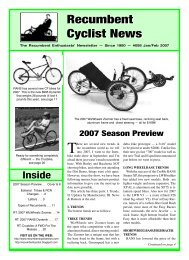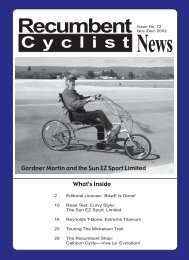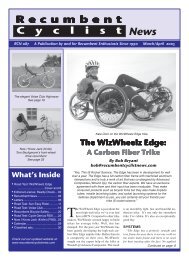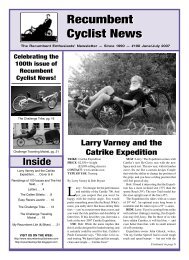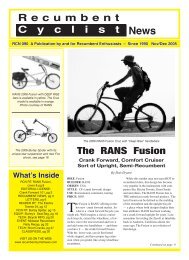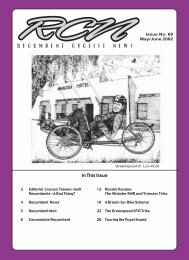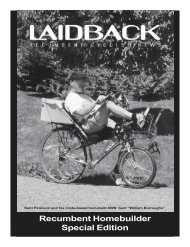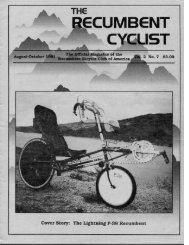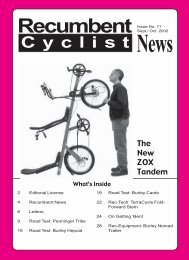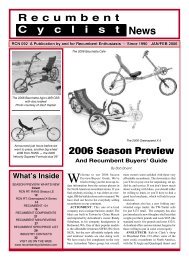C y c l i s t Recumbent - Steve Briggs
C y c l i s t Recumbent - Steve Briggs
C y c l i s t Recumbent - Steve Briggs
Create successful ePaper yourself
Turn your PDF publications into a flip-book with our unique Google optimized e-Paper software.
Everything You (may or may not) Want To Know About<br />
<strong>Recumbent</strong> Bicycle Components<br />
By Bob Bryant<br />
Bicycle components have changed a lot<br />
over the years. We’re now in a world<br />
of disposable bicycle components,<br />
many of which are marketed like computer<br />
software and updates. That is the bad news.<br />
The good news is that fine bicycle components<br />
that will last for years, or even decades, are<br />
still available if you shop carefully. They might<br />
not come as part of the $800 bargain ‘bent you<br />
bought on the web, but they do exist.<br />
Just so you don’t think I’m a bike component<br />
snob, I’ll let you know a little secret: I<br />
like good cheap bikes. The last really good<br />
cheap bike I had was made by Schwinn in<br />
Chicago in 1972, and at the moment, I don’t<br />
own a single recumbent that sells for more than<br />
$2,000. All of my views are based on personal<br />
experience, research and discussions with<br />
friends in the business. But I also remember<br />
what my dad always told me: “There is no such<br />
thing as a free lunch.”<br />
You may never have a problem with the<br />
components on your $800 bargain ‘bent, but<br />
the following information is in case you do,<br />
or in case you ever want to upgrade your bike<br />
or if you build a custom spec recumbent. I’ve<br />
gone right down the list of components that<br />
come on most recumbent bicycles. Enjoy!<br />
Cranksets<br />
Choosing the right crankset and gearing will<br />
be one of the most important decisions in selecting<br />
or building a quality recumbent bicycle.<br />
The variables are the length of the crank arm,<br />
the size of the chain ring and the quality of the<br />
crankset.<br />
Crank arm length<br />
For years we’ve relied on traditional cycling<br />
wisdom, or we’ve simply settled for the equipment<br />
chosen by the manufacturer. There is a<br />
far wider choice of components these days.<br />
One of the emerging, yet somewhat experimental<br />
trends in recumbent bicycles is the short<br />
crank arm.<br />
Fans of short cranks say they are easier on<br />
your knees and legs, provide more force to the<br />
pedals, promote spinning, provide a decrease<br />
in frontal area, improve ergonomics and decrease<br />
weight. Some riders also mention a decrease<br />
in joint pain because the pedal circle is<br />
smaller and because lower gear ranges can be<br />
used. I haven’t tried short cranks myself, but I<br />
plan to order a set soon.<br />
In the upright bicycle world the general nonscientific<br />
crank sizing goes something like this:<br />
18 <strong>Recumbent</strong> Cyclist News<br />
shorter riders use 165 mm cranks, medium size<br />
riders use 170 mm cranks and taller riders use<br />
175 mm cranks. I have found that these “standards”<br />
are often variable, and I’ve been fitted<br />
with 170 mm, 175 mm and even 180 mm<br />
cranks. I’m 6’ tall, with a 44.5” x-seam and a<br />
33.25” measured cycling inseam, and I’ve been<br />
riding with 175s for years. I’ve finally realized<br />
that they are just too long.<br />
<strong>Recumbent</strong> manufacturers may be slow to<br />
change, but there are some forward thinking<br />
manufacturers and enthusiasts out there who<br />
are talking about this. Short crank advocate<br />
Mark Stonich writes, “155 mm cranks work<br />
better than 170s for a wide range of people.<br />
Most of my customers say they spin much faster<br />
with short cranks, without feeling like they are<br />
making an effort to do so.” Mark went on to<br />
say, “Shorter cranks can be of particular benefit<br />
on ’bents with small drive wheels. The<br />
higher pedaling cadences they encourage can<br />
often eliminate the need for oversized<br />
chainrings or multispeed hubs.”<br />
Ian, Mick and Paul Sims of Greenspeed are<br />
also short crank advocates. In a recent<br />
Greenspeed newsletter, Ian wrote, “Paul took<br />
the 175 mm cranks off his personal GTR, and<br />
fitted 100 mm cranks. He found such an immediate<br />
improvement in both performance and<br />
the stress on his knees and legs, that he announced<br />
that there was no way he was ever<br />
going back to using normal size cranks.” Ian<br />
noted further, “Paul did some testing on our<br />
Computrainer dynameter. He tried four different<br />
lengths — 175, 155, 125, and 100 mm. Over<br />
the four lengths, power output was virtually<br />
constant, with a slight reduction of maximum<br />
power for the 100 mm.”<br />
Mark Mueller of Windwrap Fairings has<br />
written, “I’m 5’11” and using 110 mm cranks<br />
on my Greenspeed SLR (my primary vehicle;<br />
140 mm cranks are standard on this model)<br />
and my Volae highracer. My brother, Carl, is<br />
5’ 10.5” and runs a 143 mm crank. He says<br />
his legs and especially his knees are less fatigued<br />
with the short cranks.”<br />
Where to get short crank arms: Mark Stonich<br />
converts 155mm Dotek BMX cranks to touring<br />
triples, with 74 mm or 58 mm inner bolt<br />
circles. Complete cranksets start from $95.95<br />
on up depending on your choice of chainrings.<br />
Modified arms only are $60 or he can shorten<br />
Shimano 105s for $35. (www.bikesmith<br />
design.com)<br />
Mark offers this gear selection advice: “If<br />
you are getting spun out with 170s, gear the<br />
same with 155s. Otherwise dropping 4 or 6<br />
teeth on each ring seems to work well. Most<br />
people are going from 30-42-52 to 26-36-46<br />
or 24-34-44. Faster riders are using 28-38-48.”<br />
Mark also offers bicycle related design and<br />
metalworking services. Such as design and<br />
prototyping of many of Calhoun Cycle’s “Evolution”<br />
products.<br />
Greenspeed does crank arm shortening. Visit<br />
www.greenspeed.com.au for info.<br />
HP Velotechnik offers relatively inexpensive<br />
Tracer 155 mm 30/42/52 cranks on their bikes.<br />
These use a square taper BB and have a black<br />
finish (Zach Kaplan).<br />
Peter White Cycles offers 155 mm TA<br />
Carmina triple cranks. This buffed alloy crank<br />
has a black interchangeable spider and auto<br />
extractor bolts. It comes in many sizes from<br />
155 mm - 185 mm. This crank can be fitted<br />
with 20-24 tooth inside rings, 30-40 middle<br />
rings and 42-50 outside rings and sells for $275<br />
(www.peterwhitecycles.com).<br />
While the Hostel Shoppe has yet to advocate<br />
this new trend, it does offer short cranks<br />
for shorter riders in 150 mm and 158 mm<br />
lengths, 30/42/52, for an ISIS BB for $125.<br />
(www.hostelshoppe.com).<br />
Chainring Sizes<br />
Many recumbents come with off-the-shelf<br />
“road triple” cranksets with relatively high<br />
gears (30/42/52). Many riders will want to<br />
widen their gearing to provide lower lows, and<br />
perhaps a lower middle chain ring as well.<br />
To find gears that you need, you need a point<br />
of reference. Once you are in your regular<br />
riding shape, climb some hills and determine<br />
the gear that works best for you by counting<br />
the number of teeth on the front chain ring and<br />
the rear cog. If you don’t have a low enough<br />
gear, you need a smaller inside chain ring or a<br />
cassette with a larger inside cog. The best way<br />
to accomplish this is to replace your cassette<br />
with a wide range 11-34 and add a 24-tooth<br />
inside chain ring to your crankset. (If you need<br />
more information, read my gearing rant in<br />
RCN 079.)<br />
If you are shifting into your granny low gear<br />
too early on a hill, consider a middle chain<br />
ring with fewer teeth to lower your mid-range<br />
gearing. This is a highly personal selection<br />
process that depends on your fitness level, your<br />
home terrain, the cargo/weight you carry and<br />
the hills or mountains you ride over.<br />
To find a chainring to fit your crankset, our<br />
advice is to contact your local recumbent spe-



